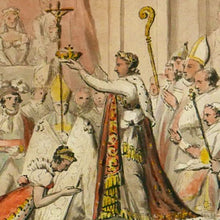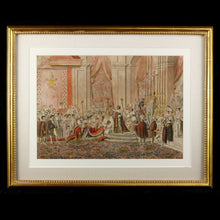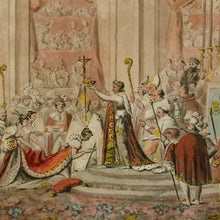The Coronation of Napoléon Bonaparte
- Regular price
- £2,800
- Sale price
- £2,800
- Regular price
-
- Unit price
- /per
Adding product to your cart
Overall: 26.5 cm (10.4in) x 38cm cm (15in)
Provenance: Ex Collection of Homan Potterton (1946-2020), Assistant Keeper National Gallery, London (1974-80); Director of the National Gallery of Ireland (1980-88).
Watercolour and ink on paper. Unsigned, circa 1815. The coronation of Napoleon was attributed by Homan Potterton to Lucius Gahagan (1773-1855) after Jacques-Louis David’s massive propaganda painting of 1805-07. It depicts the moment when Joséphine knelt before her husband in Notre Dame on 2 December 1804. To the left of the central figures are grouped Napoleon’s sisters and brothers and with their husbands and wives; the central figure in the stand behind Joséphine, is Napoléon’s mother ‘Madame Mère’ (who was actually absent on the day following a family row); as in original, the painter David occupies the upper tier of the gallery, above Madame Mère, accompanied by his wife and daughters; reluctant attendee Pope Pius VII sits behind Napoleon, anointing the proceedings; the bearded Ottoman ambassador looks on from his place above and to the right of the Pope whilst in the foreground lower right are members imperial court bearing the coronation regalia.
Lucius Gahagan (1773-1855) was the son of the Dublin sculptor Lawrence Geoghegan (active 1756-1820). Lawrence moved to London anglicised the family name to Gahagan and in 1762 married Phoebe Hunter, by whom he had four sons, Charles (born c1765), Lucius, Vincent (1776-1832) and Sebastian (1779-1838). The family operated a successful sculpture studio in Soho, producing busts of leading men of the day in marble, bronze and plaster. Their patronage was at an exalted level and in 1806 Lucius was promoting the business with the claim he was the only professional sculptor to be honoured with sittings by the great Lord Nelson at the admiral’s Bond Street lodgings (Morning Chronicle, 12.04.1806). Busts of Wellington, Blucher and William Pitt followed.
After the Battle of Waterloo in 1815 public interest in Napoleon soared. His carriage captured at Waterloo was purchased from the Government by the showman William Bullock and put on display at his Egyptian House museum in Piccadilly. The exhibit earned Bullock £35,000 in ticket sales, and caused a sensation amongst Londoners as a contemporary cartoon by Rowlandson testifies. A watercolour of Napoleon’s carriage horses by Lucius’s brother Sebastian (Sotheby’s, London, lot 116 4.12.2008) is considered a by-product of this Regency fad for all things Napoleon and possibly part of a project for Mr Bullock. Lucius’s signed and attributed watercolours of Napoleon in the late Homan Potterton’s collection might be considered in this context. Lucius relocated to Bath in 1820 and continued in the sculpture business at a house called ‘Lo Studio’.








